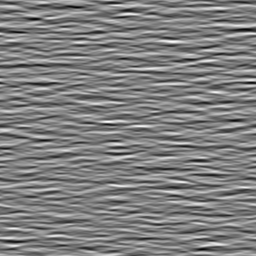Changing the global phase of a Motion Cloud
Motion Clouds were defined in the origin to define parameterized moving textures. In that other post, we defined a simple code to generate static images using a simple code. Can we generate a series of images while changing the phase globally?

Let's first generate a static motion cloud:
import MotionClouds as mc
mc.N_frame, seed = 1, 42
fx, fy, ft = mc.get_grids(mc.N_X, mc.N_Y, mc.N_frame)
name = 'phase'
env = mc.envelope_gabor(fx, fy, ft, V_X=0., V_Y=0., B_V=0)
z = mc.rectif(mc.random_cloud(env, seed=seed))
print(z.shape)
z = z.reshape((mc.N_X, mc.N_Y))
import matplotlib.pyplot as plt
%matplotlib inline
fig, ax = plt.subplots(figsize=(10,10))
_ = ax.imshow(z.T, cmap=plt.gray())
The function generating the texture takes an envelope and multiplies it with a random phase matrix to generate the image:
help(mc.random_cloud)
To globally change the phase of the gabors in the texture, a "trick" is to multiply this same envelope (such that we keep it). If we keep the same seed, we keep the same phase scrambling. Then, we perform for each coefficient in the fourier space a rotation in the complex plane (that is, by multiplying by $\exp(i\cdot\phi)$). We perform this globally on all points of the Fourier space:
N_phase = 4
fig_width = 21
import numpy as np
fig, axs = plt.subplots(1, N_phase, figsize=(fig_width, fig_width/N_phase))
for i_ax, phase in enumerate(np.linspace(0, 2*np.pi, N_phase, endpoint=False)):
im = mc.rectif(mc.random_cloud(env*np.exp(1j * phase), seed=seed))
axs[i_ax].imshow(im[:, :, 0], cmap=plt.gray())
axs[i_ax].text(5, 29, r'$\phi=%.1f$°' % (phase*180/np.pi), color='white', fontsize=32)
axs[i_ax].set_xticks([])
axs[i_ax].set_yticks([])
#plt.tight_layout()
fig.subplots_adjust(hspace = .0, wspace = .0, left=0.0, bottom=0., right=1., top=1.)
#import os
#fig.savefig(os.path.join('../figs', 'orientation_tuning.png'))
Notice that white features become black with a multiplication of $\exp(i\cdot\pi)=-1$
For fun, let us now try to generate an animation:
import imageio
from pygifsicle import optimize
N_phase = 32
fps, dpi = 8, (128, 128)
for i_phase, phase in enumerate(np.linspace(0, 2*np.pi, N_phase, endpoint=False)):
im = (mc.rectif(mc.random_cloud(env*np.exp(1j * phase), seed=seed))*255).astype(np.uint8)
imageio.imsave(f"/tmp/MC_phase_{i_phase:02d}.png", im, dpi=dpi)
gifname = '../files/2020-01-08-MC_phase.gif'
with imageio.get_writer(gifname, mode='I', fps=fps) as writer:
for i_phase in range(N_phase):
writer.append_data(imageio.imread(f"/tmp/MC_phase_{i_phase:02d}.png"))
optimize(str(gifname))
from IPython.display import Image
Image(gifname, width=2000)
For even more fun, let us now try to generate an animation of this process, but now for a natural scene:
N_phase = 32
fps, dpi = 8, (128, 128)
url = 'https://external-content.duckduckgo.com/iu/?u=http%3A%2F%2Fwww.trbimg.com%2Fimg-57c7186a%2Fturbine%2Fmc-paul-stanley-kiss-allentown-fair-20160831&f=1&nofb=1'
image = imageio.imread(url)
image.shape
image = image.sum(axis=-1)
image.shape
image = image[:-1:2, ::2]
image.shape
from SLIP import Image
slip = Image('https://raw.githubusercontent.com/bicv/SLIP/master/default_param.py')
slip.set_size(image)
image = slip.whitening(image)
Fz = np.fft.fftn(image)
phase = 0
im = np.fft.ifftn(Fz*np.exp(1j * phase)).real
mc.rectif(im).min(), mc.rectif(im).max()
for i_phase, phase in enumerate(np.linspace(0, 2*np.pi, N_phase, endpoint=False)):
# print(i_phase, phase, f"/tmp/NI_phase_{i_phase:02d}.png")
im = np.fft.ifftn(Fz*np.exp(1j * phase)).real
im = slip.dewhitening(im)
im = (mc.rectif(im)*255).astype(np.uint8)
imageio.imsave(f"/tmp/NI_phase_{i_phase:02d}.png", im, dpi=dpi)
gifname = '../files/2020-01-08-NI_phase.gif'
with imageio.get_writer(gifname, mode='I', fps=fps) as writer:
for i_phase in range(N_phase):
writer.append_data(imageio.imread(f"/tmp/NI_phase_{i_phase:02d}.png"))
optimize(str(gifname))

Note, that doing a smooth variation of phase produces slight movements of the features, at the scale of each texton.
some book keeping for the notebook¶
%load_ext watermark
%watermark
%load_ext watermark
%watermark -i -h -m -v -p MotionClouds,numpy,SLIP,LogGabor,SparseEdges,matplotlib,scipy,pillow,imageio -r -g -b